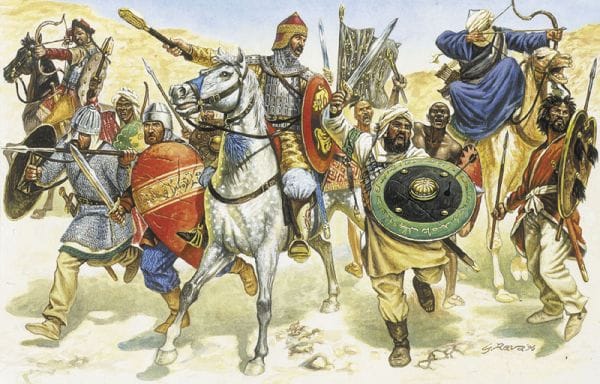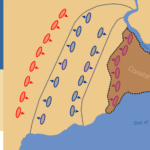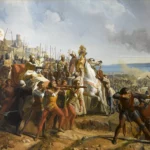The clash between the mighty Byzantine and burgeoning Arab empires irrevocably shaped the history of the Middle East. From the 7th to the 11th centuries, these titans grappled for dominance in a series of epic confrontations known as the Arab-Byzantine Wars. These wars were more than mere territorial disputes; they were a whirlwind of cultural exchange, religious fervor, and military innovation that echoed throughout history.
Arab-Byzantine Wars: Shaping the Middle East
Imagine a world redrawn as two powerful forces collide. On one side stood the Byzantine Empire, heir to the Roman legacy and a bastion of Christianity. On the other, the nascent Muslim Arab dynasties, fueled by the teachings of Islam and a hunger for expansion, rose to challenge the established order.
The year 636 AD saw the earth-shattering clash at the Battle of Yarmouk. The seemingly invincible Byzantine army was devastated, resulting in the loss of Syria and signaling a turning point in the empire’s fortunes. The Battle of Manzikert in 1071 AD further cemented the Arab ascendancy, as the Byzantines lost swathes of their eastern territories to the Seljuk Turks.
Amidst the chaos of war, a remarkable cultural exchange unfolded. The Arabs, eager for knowledge, absorbed Byzantine innovations such as silk production and the secrets of Greek fire, a devastating incendiary weapon. The Byzantines, in turn, were captivated by Arab art and architecture, seamlessly weaving these influences into their own traditions.
The impact of these wars was monumental. The Byzantine Empire, once a beacon of power, found itself grappling with diminished territory and internal strife. Conversely, the Arab dynasties ascended to prominence, dictating the political and religious landscape of the Middle East for centuries to come. The echoes of this clash continue to resonate today, reminding us of the enduring legacy forged in the crucible of the Arab-Byzantine Wars.
What Were the Arab-Byzantine Wars?
The Arab-Byzantine Wars were a protracted struggle for supremacy between two empires with contrasting ideologies. The Muslim Arab armies, spearheaded by the Rashidun and Umayyad caliphs, erupted from the Arabian Peninsula, energized by their faith and led by brilliant tacticians. Their objective: to spread Islam and expand their domain. The Byzantine Empire, although beset by internal challenges, fiercely defended its territories with the tenacity of emperors like Heraclius.
This historical tug-of-war raged for over four centuries. Alliances shifted like desert sands, punctuated by sieges, daring raids, and naval battles across the Mediterranean. The rise of the Arab empires irrevocably redrew the map of the Middle East, while the Byzantine Empire, though weakened, clung tenaciously to its remaining territories.
The impact transcended the battlefield, igniting a cultural exchange that enriched both civilizations. Arab scholars delved into ancient Greek texts, while Byzantine artistic and architectural influences permeated the Islamic world. The pressures of these conflicts even contributed to the development of feudalism in Western Europe, as new defensive strategies became necessary.
The legacy of the Arab-Byzantine Wars is deeply interwoven with the geopolitical landscape of the modern Middle East. The interplay between different faiths and the struggle for power and influence are enduring themes that continue to shape the region today.
Causes and Timeline of the Arab-Byzantine Wars
The seeds of conflict between the Arab and Byzantine empires were sown by a complex interplay of religious fervor, political instability, and devastating pandemics.
Causes – A Recipe for Conflict
The rise of Islam in the 7th century was a pivotal moment in world history. Driven by their faith and the teachings of the Prophet Muhammad, Muslim Arabs embarked on a path of expansion, determined to spread their beliefs. This expansion brought them into direct conflict with the Byzantine Empire, setting the stage for centuries of warfare.
The Byzantine Empire, despite its glorious past, was grappling with internal challenges. Political turmoil and economic woes weakened its defenses, making it vulnerable to attack. The bubonic plague, a devastating pandemic that swept across both empires, further exacerbated the situation, creating a power vacuum that the ambitious Arabs were poised to exploit.
Timeline – Centuries of Struggle
The Arab-Byzantine Wars unfolded over centuries, marked by pivotal battles and shifting tides of power:
| Century | Major Events |
|---|---|
| 7th Century | The Rashidun Caliphate, leading the charge for the Muslim Arabs, secured vital territories, including Syria, Egypt, and North Africa, dealing a significant blow to the Byzantine Empire. |
| 8th Century | The Umayyad Caliphate continued the Arab advance, conquering Spain and engaging in a constant back-and-forth struggle for dominance with the Byzantines. |
| 9th Century | The rise of the Abbasid Caliphate added another layer of complexity to the conflict, as they challenged the Byzantines from the east. |
| 10th Century | The Byzantine Empire experienced a resurgence, reclaiming some lost territories. However, internal divisions continued to plague the empire, preventing a full recovery. |
| 11th Century | The Seljuk Turks, a new power on the scene, delivered a crushing defeat to the Byzantines at the Battle of Manzikert, capturing Anatolia and marking a turning point in the balance of power. |
The Arab-Byzantine Wars were more than just territorial conquests; they were a clash of civilizations, each vying for dominance. The outcomes of these wars shaped the political, religious, and cultural landscape of the Middle East for centuries to come.
Major Battles and Military Strategies
The Arab-Byzantine Wars, fueled by religious fervor, power struggles, and even pandemics like the bubonic plague, reshaped the Middle East for centuries. These epic clashes witnessed the rise and fall of empires, marked by decisive battles that altered the course of history.
The Battle of Yarmouk in 636 AD stands as a testament to the strategic brilliance of the Arab general Khalid ibn al-Walid. His decisive victory against the Byzantine forces paved the way for the Muslim conquest of Syria, marking a turning point in the balance of power.
The Siege of Constantinople from 674-678 AD showcased the resilience of the Byzantine capital. Despite being surrounded by the relentless Arab armies, Constantinople’s formidable defenses held firm. This victory was pivotal for the Byzantine Empire, as the fall of their capital could have spelled their demise.
However, the Battle of Manzikert in 1071 AD dealt a devastating blow to the Byzantines. The loss of Anatolia (modern-day Turkey) significantly weakened their hold on the region, marking a significant turning point in the wars.
The contrasting military strategies employed by both sides provide a fascinating glimpse into the nature of warfare during this period.
The Byzantine Empire boasted a formidable military machine. Their strategic prowess was evident in their deployment of cavalry, infantry, and navy. They even developed innovative weapons like “Greek fire,” a terrifying incendiary weapon that gave them a tactical advantage.
The Arabs, on the other hand, were masters of speed and maneuverability. Their cavalry, known for its swiftness and agility, could sweep across battlefields with devastating force. The use of camel-mounted troops added another dimension to their tactics, providing a unique advantage in desert warfare.
The Key Takeaway:
The Arab-Byzantine Wars were more than just isolated skirmishes; they were a seismic event that irrevocably changed the political and cultural landscape of the Middle East. The echoes of these ancient clashes can still be felt today, highlighting the enduring legacy of this epic struggle.
Discover the intense battle between the Arabs and Byzantines during the siege of Constantinople 717, a pivotal moment in the history of the Byzantine Empire.
Key Points of the Arab-Byzantine Wars:
- Conflicts: A series of wars fought between the Christian Byzantine Empire and various Muslim Arab empires from the 7th to 11th centuries.
- Motivations: Driven by a combination of factors, including religious expansionism, territorial ambitions, and political instability.
- Muslim Conquests: Led to the expansion of the Islamic caliphates, including the Umayyad and Abbasid caliphates, at the expense of the Byzantine Empire.
- Duration: Four centuries of conflict marked by shifting alliances, periods of intense warfare, and moments of relative peace.
- Impact on Western Europe: The pressures of these conflicts indirectly influenced the development of feudalism in Western Europe.
- Cultural Exchange: Facilitated the exchange of knowledge, ideas, and artistic influences between the Arab and Byzantine worlds.
- Legacy: The wars continue to be studied and debated by historians, and their legacy can still be felt in the geopolitical dynamics of the Middle East today.

















Comments are closed.